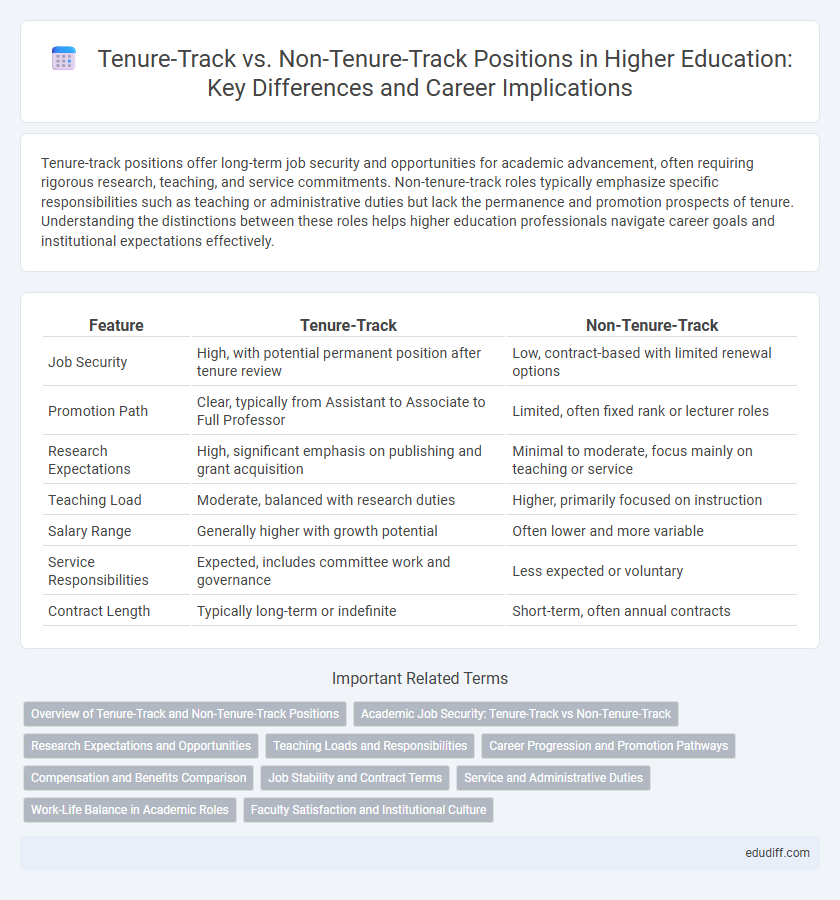Tenure-track positions offer long-term job security and opportunities for academic advancement, often requiring rigorous research, teaching, and service commitments. Non-tenure-track roles typically emphasize specific responsibilities such as teaching or administrative duties but lack the permanence and promotion prospects of tenure. Understanding the distinctions between these roles helps higher education professionals navigate career goals and institutional expectations effectively.
Table of Comparison
| Feature | Tenure-Track | Non-Tenure-Track |
|---|---|---|
| Job Security | High, with potential permanent position after tenure review | Low, contract-based with limited renewal options |
| Promotion Path | Clear, typically from Assistant to Associate to Full Professor | Limited, often fixed rank or lecturer roles |
| Research Expectations | High, significant emphasis on publishing and grant acquisition | Minimal to moderate, focus mainly on teaching or service |
| Teaching Load | Moderate, balanced with research duties | Higher, primarily focused on instruction |
| Salary Range | Generally higher with growth potential | Often lower and more variable |
| Service Responsibilities | Expected, includes committee work and governance | Less expected or voluntary |
| Contract Length | Typically long-term or indefinite | Short-term, often annual contracts |
Overview of Tenure-Track and Non-Tenure-Track Positions
Tenure-track positions in higher education typically offer a pathway to permanent employment, emphasizing research, teaching, and service responsibilities with rigorous evaluation processes. Non-tenure-track roles often focus on teaching or specialized duties, with contracts that may be renewable but lack long-term job security. Understanding the distinctions between these positions helps clarify academic career trajectories and institutional priorities.
Academic Job Security: Tenure-Track vs Non-Tenure-Track
Tenure-track positions offer substantial academic job security through a clear pathway to permanent appointment, typically after a probationary period of five to seven years. Non-tenure-track roles often lack long-term employment guarantees, relying on renewable contracts that can vary in length from one semester to multiple years. The stability of tenure-track appointments supports sustained research, teaching, and service contributions essential for career advancement in higher education.
Research Expectations and Opportunities
Tenure-track positions in higher education typically require substantial research output, including peer-reviewed publications and grant acquisition, to secure permanent status. Non-tenure-track roles often prioritize teaching and service over research, providing fewer opportunities and resources for sustained scholarly projects. Faculty on tenure-track paths benefit from institutional support and protected time to foster research innovation and academic advancement.
Teaching Loads and Responsibilities
Tenure-track faculty typically have balanced teaching loads combined with significant research and service expectations, often teaching 2-3 courses per semester. Non-tenure-track instructors usually face heavier teaching responsibilities, frequently managing 4-5 courses per semester, with limited or no research obligations. This distinction significantly impacts workload distribution, job security, and opportunities for career advancement within higher education institutions.
Career Progression and Promotion Pathways
Tenure-track positions in higher education offer structured career progression with clearly defined milestones for promotion, including rigorous evaluations of research, teaching, and service, leading to potential job security and academic tenure. Non-tenure-track roles often emphasize contract renewals or fixed-term appointments with limited promotion pathways, primarily focusing on teaching or specialized administrative duties rather than research output. The disparity in promotion opportunities impacts long-term career development, with tenure-track faculty typically accessing leadership roles and greater institutional influence.
Compensation and Benefits Comparison
Tenure-track positions typically offer higher base salaries and comprehensive benefits packages, including retirement plans, health insurance, and research funding, compared to non-tenure-track roles that often feature lower pay and limited benefits. Non-tenure-track faculty may receive stipends or temporary contracts without guaranteed salary increments or long-term financial security. The disparity in compensation and benefits reflects differing expectations of job security, professional development opportunities, and institutional commitment in higher education.
Job Stability and Contract Terms
Tenure-track positions in higher education offer greater job stability through long-term contracts and the potential for tenure, providing faculty with academic freedom and protection from arbitrary dismissal. Non-tenure-track roles typically involve short-term, renewable contracts without tenure guarantees, leading to less predictability and increased employment insecurity. Contract terms for tenure-track faculty often include clear paths for promotion and permanent status, whereas non-tenure-track contracts prioritize flexibility and are more contingent on institutional needs.
Service and Administrative Duties
Tenure-track faculty members typically carry a heavier load of service and administrative duties, including committee participation, departmental leadership, and university governance, reflecting expectations for long-term institutional contribution. Non-tenure-track faculty often have reduced service responsibilities to prioritize teaching and research output, with fewer obligations in administrative roles. This distinction impacts workload distribution and career progression opportunities within higher education institutions.
Work-Life Balance in Academic Roles
Tenure-track positions often demand extensive research, teaching, and service responsibilities, which can challenge work-life balance due to high expectations for publishing and grant acquisition. Non-tenure-track roles, such as adjunct or lecturer positions, might offer more predictable schedules and fewer research obligations, potentially allowing greater flexibility and personal time. However, these positions may lack job security and benefits, influencing overall work-life satisfaction differently than tenure-track roles.
Faculty Satisfaction and Institutional Culture
Faculty satisfaction in tenure-track positions often stems from job security, opportunities for research funding, and clearer pathways for career advancement, which foster a stable and engaged academic environment. Non-tenure-track faculty may experience lower satisfaction due to limited job security and fewer opportunities for professional development, impacting overall institutional culture by creating divisions within faculty ranks. Institutions emphasizing support and equitable treatment across all faculty types tend to cultivate a more inclusive culture, enhancing satisfaction and collaboration.
Tenure-track vs Non-tenure-track Infographic

 edudiff.com
edudiff.com